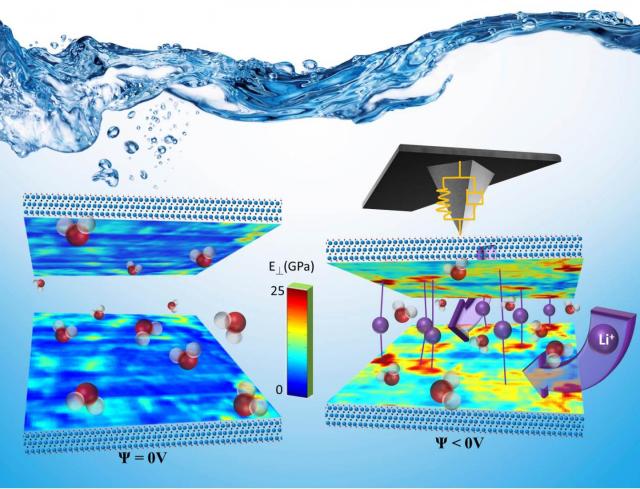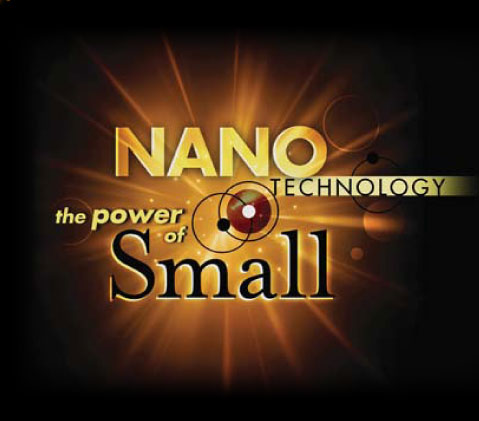Hybrid materials developed at Berkeley Lab could lead to cheaper ways to reduce power plant greenhouse gas emissions
In this animation, exhaust from a power plant contacts a hybrid membrane recently developed at Berkeley Lab. The membrane’s carbon dioxide highways (yellow) enable the rapid flow of carbon dioxide (red and white molecules) while maintaining selectivity over nitrogen (blue molecules). The membrane is eight times more carbon dioxide permeable than a polymer-only membrane. (Credit: Berkeley Lab)
A new, highly permeable carbon capture membrane developed by scientists from the U.S. Department of Energy’s Lawrence Berkeley National Laboratory (Berkeley Lab) could lead to more efficient ways of separating carbon dioxide from power plant exhaust, preventing the greenhouse gas from entering the atmosphere and contributing to climate change.
The researchers focused on a hybrid membrane that is part polymer and part metal-organic framework, which is a porous three-dimensional crystal with a large internal surface area that can absorb enormous quantities of molecules.
In a first, the scientists engineered the membrane so that carbon dioxide molecules can travel through it via two distinct channels. Molecules can travel through the polymer component of the membrane, like they do in conventional gas-separation membranes. Or molecules can flow through “carbon dioxide highways” created by adjacent metal-organic frameworks.
Initial tests show this two-route approach makes the hybrid membrane eight times more carbon dioxide permeable than membranes composed only of the polymer. Boosting carbon dioxide permeability is a big goal in efforts to develop carbon capture materials that are energy efficient and cost competitive.
The research is the cover article of the March issue of the journal Energy & Environmental Science.
“In our membrane, some CO2 molecules get an express ride through the highways formed by metal-organic frameworks, while others take the polymer pathway. This new approach will enable the design of higher performing gas separation membranes,” says Norman Su, a graduate student in the Chemical and Biomolecular Engineering Department at UC Berkeley and a user at the Molecular Foundry.
He conducted the research with Jeff Urban, Facility Director of the Inorganic Nanostructures Facility at the Molecular Foundry, and a team of scientists that included staff at the Advanced Light Source.
Capturing carbon emissions from electric power plants and other sources is a hot research topic because there’s a lot of room for improvement. The conventional way of separating carbon dioxide from flue gas is amine adsorption, which isn’t economical at scale because it adds significant capital cost and reduces the electrical output of power plants.
Scientists are exploring polymer membranes as a more energy efficient alternative to amine adsorption. These membranes are relatively inexpensive and easy to work with, but current commercial membranes have low carbon dioxide permeability. To overcome this, scientists have developed hybrid membranes that are part polymer and part metal-organic framework. These hybrids harness the carbon dioxide selectivity of metal-organic frameworks while maintaining the processability of polymers.
But, until now, scientists have not been able to engineer hybrid membranes with enough metal-organic frameworks to form continuous channels through the membrane. This means that, somewhere in a carbon dioxide molecule’s journey through the membrane, the molecule must contact the polymer. This constrains the molecule’s transport to the polymer.
In this latest research, Berkeley Lab scientists have developed a hybrid membrane in which metal-organic frameworks account for 50 percent of its weight, which is about 20 percent more than other hybrid membranes. Previously, the mechanical stability of a hybrid membrane limited the amount of metal-organic frameworks that could be packed in it.
“But we got our membrane to 50 weight percent without compromising its structural integrity,” says Su.
And 50 weight percent appears to be the magic number. At that threshold, there are so many metal organic frameworks in the membrane that they form a continuous network of highways through the membrane. When that happens, the hybrid membrane switches from having a single channel to transport carbon dioxide, in which the molecules must go through the polymer, to two channels, in which the molecules can either move through the polymer or through the metal-organic framework highways.
“This is the first hybrid polymer-MOF membrane to have these dual transport pathways, and it could be a big step toward more competitive carbon capture processes,” says Su.
In addition to fabricating the hybrid membrane at the Molecular Foundry, the scientists analyzed the material at beamline 12.2.2 of the Advanced Light Source.
The research was supported by the Department of Energy’s Office of Science, Berkeley Lab’s Laboratory-Directed Research and Development Program, and the Department of Defense.
The Advanced Light Source and the Molecular Foundry are DOE Office of Science User Facilities located at Berkeley Lab.
###
Lawrence Berkeley National Laboratory addresses the world’s most urgent scientific challenges by advancing sustainable energy, protecting human health, creating new materials, and revealing the origin and fate of the universe. Founded in 1931, Berkeley Lab’s scientific expertise has been recognized with 13 Nobel prizes. The University of California manages Berkeley Lab for the U.S. Department of Energy’s Office of Science. For more, visit www.lbl.gov.
DOE’s Office of Science is the single largest supporter of basic research in the physical sciences in the United States, and is working to address some of the most pressing challenges of our time. For more information, please visit science.energy.gov
Updated: March 17, 2016











You must be logged in to post a comment.